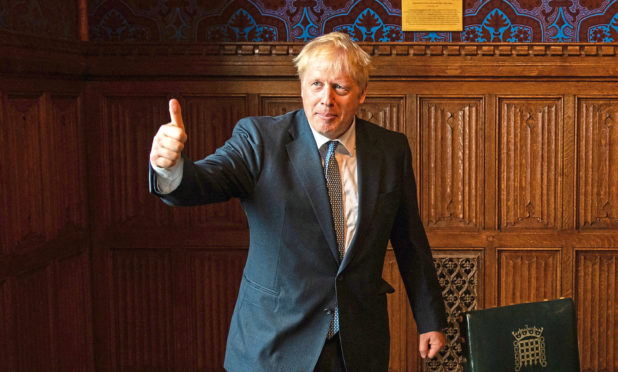Boris sucks in words from all other stories, leaving only the great Bojo show on the news.
You can almost feel the type being dragged across the page. Letters, words and punctuation that would otherwise be telling us of the latest SNP policy failure (the death of its Education Bill) or Trump’s wish for war in Iran just won’t be tamed to those topics.
Instead, the Boris black hole is passing through – all-consuming, never-revealing.
Rival parties and politicians may hate him, but quietly give thanks for the cover he provides.
When Bojo is in town, all days are good days to bury bad news. Except, of course, for Johnson himself.
And the news is getting pretty bad, such that the once-invincible front-runner for leader of the Tory party, and therefore prime minister, no longer looks a sure thing.
While ahead against his rival Jeremy Hunt in popularity within Tory membership – the only constituency that matters in choosing the leader – there is other polling information that points to failure.
A feature of the Theresa May years was that no matter how much she messed things up, Labour always ran in second.
Jeremy Corbyn’s failure was that he could not dent the Tory lead.
However, since April 5, the Tories have slipped.
In a tight field, Labour just sneaks ahead of the Brexit Party and then the Tories in aggregated opinion polls.
All are clustered around the 20% mark, with Labour on 23%.
The Tories have lost votes to the Brexit Party and to the Lib Dems.
The assumption is that Brexit will be delivered on October 31 and the political world will revert to the normal two-party system.
However, the chance of Brexit by the latest deadline is slim – it looks simply impossible to do in the time frame.
Further, Johnson’s strategy for getting it done seems childish – he plans to drop the Irish backstop from the deal, and address the matter later.
As nothing suggests the EU will accept this, there’s no reason to think he’ll succeed.
If not, he says, it’s a no-deal Brexit.
UK banking and business think this is the economic equivalent of running into a fire, so Remainers will fight to stop this happening. That could mean Johnson never actually becomes PM.
The Commons will pass a vote of no confidence in his leadership before the Queen can announce him as her prime minister.
Or no-deal will be blocked by parliament, forcing a general election, at which the Tories are likely to poll under 20% (the latest failure on Brexit further diminishing the brand).
It is convenient to think of the Tory membership as the outraged of Sevenoaks, but they are as wise, and foolish, as any other membership.
Unlike any other membership, they are organised in branches which are affiliated to the central office, but not actually owned or controlled by it.
Which is to say, they have a tradition of independence.
The choice faced by these people is first to elect a new leader, but then to fight an election, which must come round by 2023, but will almost certainly happen much sooner.
Boris may appeal to them, and his bullish talk on Brexit as inspiring as a Rhinemaiden in a Wagner opera, but there is no evidence Boris appeals to Britons in general.
A politico poll carried out in May showed Boris is loathed by Remainers and centrists – which suggests he would fail to win an election. Admittedly, this has to be weighed against Corbyn’s leadership of Labour, which also repels Remainers and centrists.
The next UK election, on current form, would likely see the two-party system ended. A four-way result, including Liberal Democrats and the Brexit Party, would make it anyone’s guess who would get the keys to Number 10.
Thus choosing Boris to lead is a vanity – he doesn’t have what it takes to unite the Tory party or the country.
The more that is seen of his cowardice in debate, his private life, his failure on detail, the less compelling his leadership case becomes.
This must worry the Tories.
Do they elect Boris as the suicide pilot to take them through Brexit and hang the consequences, and the party, or are they trying to rebuild as a serious political force?
If it’s the latter, then Jeremy Hunt looks a better bet. On Hunt can be written a story that sticks, about being a straight-up guy doing a pragmatic job.
The great black hole of Boris not only sucks in words, but threatens to consume the history of the Conservative Party.
The polling evidence suggests his mewling, messy depths could swallow the memory of Peel and Disraeli, of Churchill and Thatcher.
Paradoxically, Johnson puts at risk the existence of the most successful political party in modern history.
He jeopardises a tradition that is as much a part of England as the church and the crown.
The Bojo black hole may not discriminate in what it destroys.
As his campaign falters, Hunt may yet win. Bye, bye the funny guy, long live the Tories.










